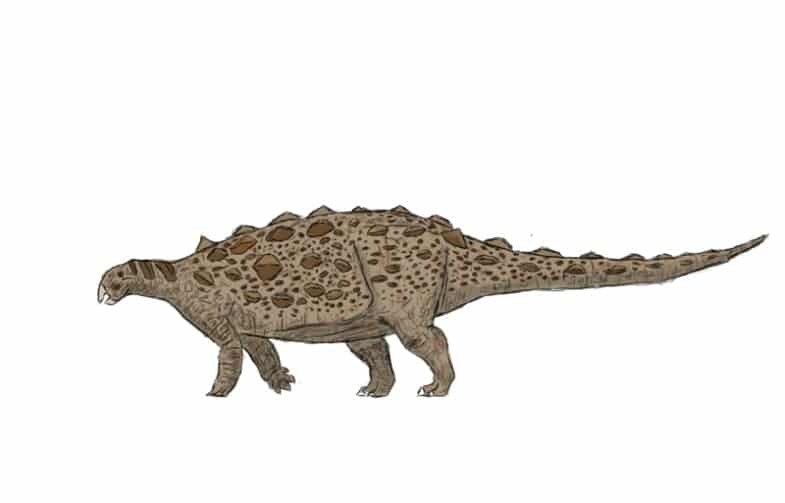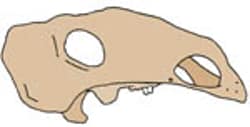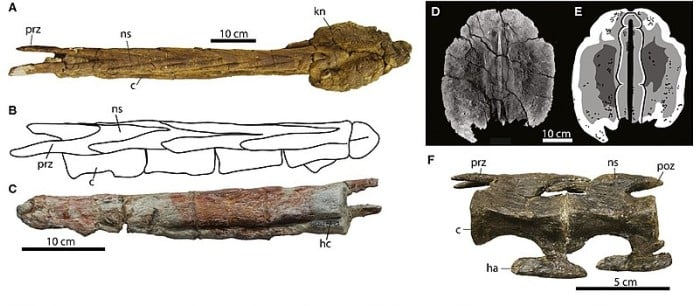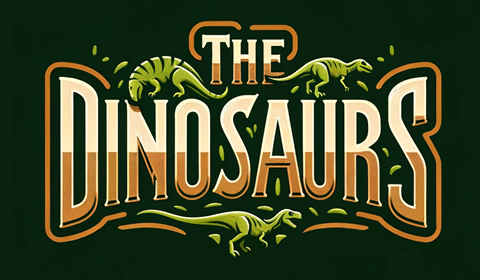When we think of dinosaurs, our minds often conjure images of towering creatures that roamed the Earth millions of years ago. Among these ancient giants, Gobisaurus holds a special place. Discovered in the vast expanse of the Gobi Desert, this herbivorous dinosaur from the Late Cretaceous Period offers a fascinating glimpse into a world long gone.
Gobisaurus, whose name aptly means “Gobi (Desert) Lizard,” is a testament to the incredible diversity of life that once thrived on our planet. Its discovery and subsequent studies have provided valuable insights into the ecosystems of the past, shedding light on the intricate web of life that existed during its time.
Gobisaurus Key Facts
| Keyword | Fact |
|---|---|
| Pronunciation | Go-bee-sore-us |
| Meaning of name | Gobi (Desert) Lizard |
| Group | Ankylosauria |
| Type Species | Gobisaurus domoculus |
| Diet | Herbivore |
| When it Lived | 125.0 to 100.5 MYA |
| Period | Early Cretaceous |
| Epoch | Albian-Aptian(?) |
| Length | 16.0 to 23.0 feet |
| Height | Approximately 5.7 feet |
| Weight | Approximately 2.0 tons |
| Mobility | Quadruped |
| First Discovery | 1959–1960 by Sino-Soviet Expeditions |
| Location of first find | Gobi Desert, Mongolia |
| First Described by | 2001 by Matthew Vickaryous, Anthony Russell, Philip John Currie and Zhao Xijin |
| Holotype | IVPP V12563 |
Gobisaurus Origins, Taxonomy and Timeline
Gobisaurus, a name that whispers tales of ancient deserts and long-lost worlds, is a fascinating relic from the past. Its name, meaning “Gobi (Desert) Lizard,” is a nod to its origins in the vast and enigmatic Gobi Desert. This name not only signifies its geographical roots but also connects it to the grand lineage of reptiles, as indicated by the suffix ‘saurus’. Its specific type species, Gobisaurus domoculus, is the only species of the genus. The term ‘domoculus’, translating to “hidden from view” in Latin, reflects the initial oversight of this species in the scientific community.

Part of the Ankylosauria group, Gobisaurus is a proud member of the Ankylosauridae. A paper from 2022 suggests it could represent the earliest-diverging ankylosaurid.
The timeline of Gobisaurus is etched into the Early Cretaceous Period, specifically spanning from possibly the Aptian to the Albian Age. This places its existence approximately between 125.0 and 100.5 million years ago, a time when dinosaurs reigned supreme. The holotype, IVPP V12563 was found in a layer of the Ulansuhai Formation. Comprising a skull and other postcranial remains yet to be fully described, IVPP V12563 is a testament to Gobisaurus’ journey through time and the ever-evolving narrative of paleontology. Another taxon, ‘Zhongyuansaurus’, found in the same area, likely represent a juvenile specimen of Gobisaurus.
Discovery & Fossil Evidence
Gobisaurus was found during a Sino-Soviet Expeditions of 1959–1960 in the Gobi desert (formed by researchers from the Institute of Vertebrate Paleontology and paleoanthropology of Beijing, China; and the Paleontological Institute of Moscow, Russia). It is composed of both cranial and postcranial elements of a single individual. Initially, this significant find was largely overlooked, lying dormant in the annals of paleontological discoveries.

Greygirlbeast at en.wikipedia, CC BY-SA 3.0, via Wikimedia Commons
It wasn’t until the 1990s that Gobisaurus began to capture attention. As part of the China-Canada Dinosaur Project, its skull was showcased in a global traveling exhibition from 1990 to 1997, and was informally named Gobisaurus at the time.

Victoria M. Arbour and Philip J. Currie, CC BY 4.0, via Wikimedia Commons
In 2001, Matthew Vickaryous, Anthony Russell, Philip John Currie, and Zhao Xijin officially named and described the type species Gobisaurus domoculus in a formal scientific publication. Only the skull was described at the time and the postcranial material still need to be formally published.
Gobisaurus Size and Description
Gobisaurus, presents a fascinating puzzle for paleontologists. While much about this dinosaur remains shrouded in mystery, certain aspects of its size and physical characteristics can be inferred from the available evidence.
Description of Gobisaurus
Gobisaurus was quadrupedal. Our understanding of its body shape is limited, primarily because the only remains published so far are of its skull. This skull, measuring 18.0 inches in length and 17.5 inches across, provides valuable clues but leaves much to the imagination regarding the rest of its physique.
Size and Weight of Type Species
Estimating the size of Gobisaurus is a challenging endeavor. Paleontologist Thomas Holtz suggested a length of around 16.0 feet. This estimation aligns with the notion that Gobisaurus is a sister species to Shamosaurus, a medium-sized Ankylosaurian. In 2010, Gregory Paul estimated the body length of Shamosaurus at 16.0 feet and its weight at 2.2 tons. In 2012, Holtz provided a higher estimation of 23.0 feet for the Shamosaurus. These figures, while speculative, offer a glimpse into the possible stature of this intriguing dinosaur.
Contemporary Dinosaurs
In the ancient, arid landscapes of what we now know as nowadays Mongolia and China, Gobisaurus, a hefty, armored dinosaur, lumbered across the terrain. Its life was a constant dance of survival and coexistence with a cast of contemporaries, each playing a unique role in the ecosystem’s intricate ballet.
The original publication stipulates that Gobisaurus was found in the same layers than ‘Chilantaisaurus’ maortuensis now Shaochilong maortuensis, a carnivorous theropod. Gobisaurus, despite its size and armor, might have had to keep a vigilant eye for these cunning hunters. A clash between them would have been a dramatic display of brawn versus agility, a testament to the survival challenges in their shared world. Through these interactions, Gobisaurus, a seemingly indomitable creature, reveals its role in a complex web of coexistence, competition, and survival in a vibrant, prehistoric ecosystem.
In Gobisaurus path was often Beg tse, a neoceratopsian. These two, clad in natural armor, might have been occasionally competing for the lush vegetation that dotted their world. Their interactions, though possibly competitive, were likely more a silent contest of who could munch more greens under the blazing prehistoric sun.
Interesting Points about Gobisaurus
- Gobisaurus was discovered in the Gobi Desert, a location rich in dinosaur fossils.
- It belongs to the ankylosaurid family, known for their armored bodies.
- Gobisaurus lived during the Early Cretaceous Period, a time of great dinosaur diversity.
- Its name, meaning “Gobi (Desert) Lizard,” reflects both its discovery location and reptilian nature.
Gobisaurus in its Natural Habitat
Gobisaurus thrived in an environment that was both challenging and dynamic. The climate and geography of its habitat, coupled with the vegetation of the time, created a complex ecosystem. As a herbivore, Gobisaurus played a vital role in this system, its diet and locomotion shaping its interactions with the surrounding landscape.
The social behavior of Gobisaurus, whether it was a solitary wanderer or a herd animal, remains a subject of fascination. Its senses, adapted to its environment, would have been crucial for survival. The impact of Gobisaurus on its ecosystem, whether through shaping the landscape or its role in the food chain, adds another layer to our understanding of this ancient world.
Frequently Asked Questions
It means “Gobi (Desert) Lizard,” reflecting its discovery location and reptilian nature.
It lived during the Late Cretaceous Period, approximately 125.0 to 89.8 million years ago.
It was a herbivore, feeding on the vegetation of its time.
It was first discovered in the Gobi Desert, Mongolia, by the Sino-Soviet Expeditions.
It was described in 2001 by Matthew Vickaryous, Anthony Russell Philip John Currie, and Zhao Xijin.
It belongs to the Ankylosauria group, within the Ankylosaurid family.
Sources
The information in this article is based on various sources, drawing on scientific research, fossil evidence, and expert analysis. The aim is to provide a comprehensive and accurate overview of Gobisaurus. However, please be aware that our understanding of dinosaurs and their world is constantly evolving as new discoveries are made.
This article was last fact-checked: Joey Arboleda, 11-04-2023; Alienor Duhamel 11-14-2023
Featured Image Credit: Foolp, CC BY-SA 4.0 https://creativecommons.org/licenses/by-sa/4.0, via Wikimedia Commons
